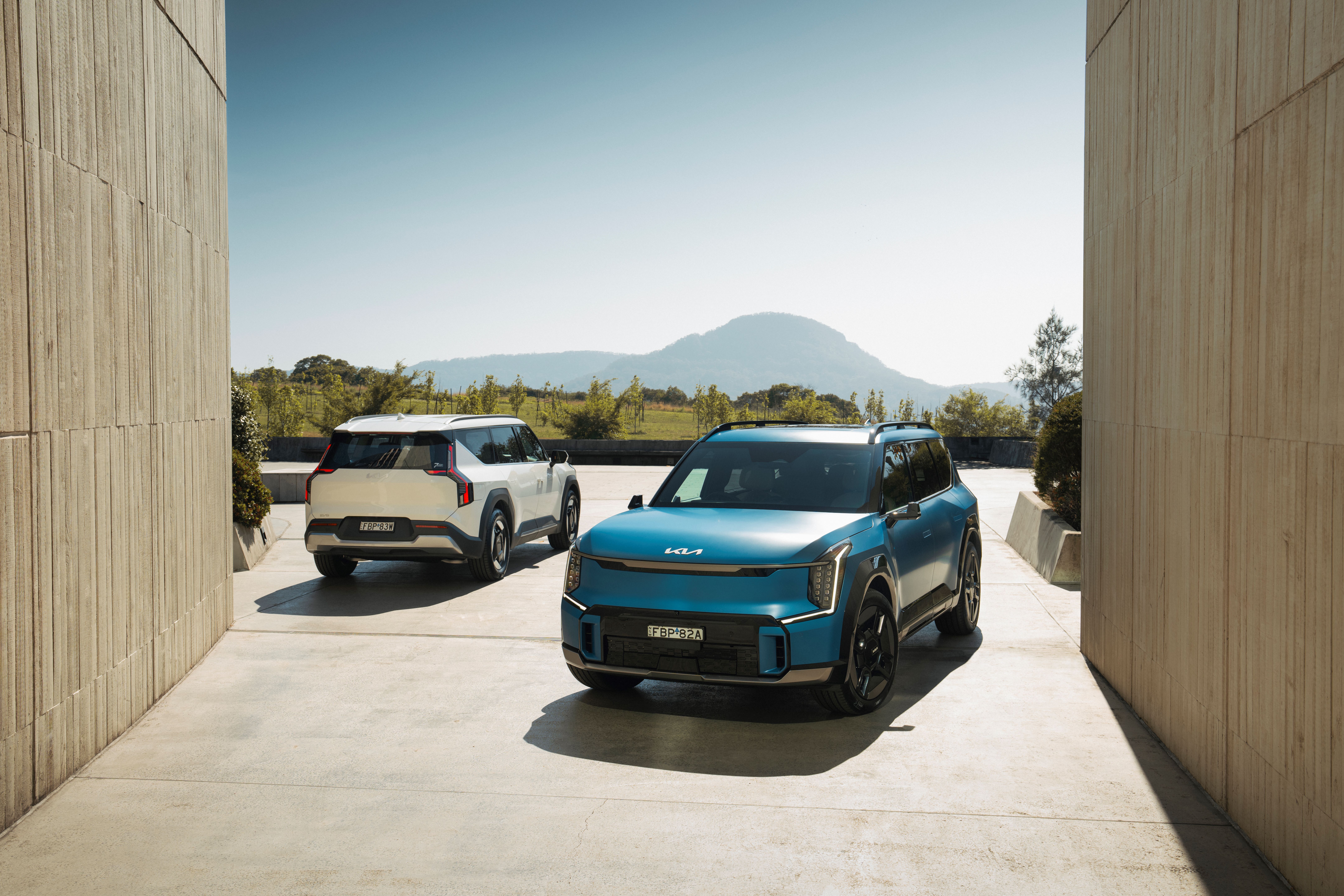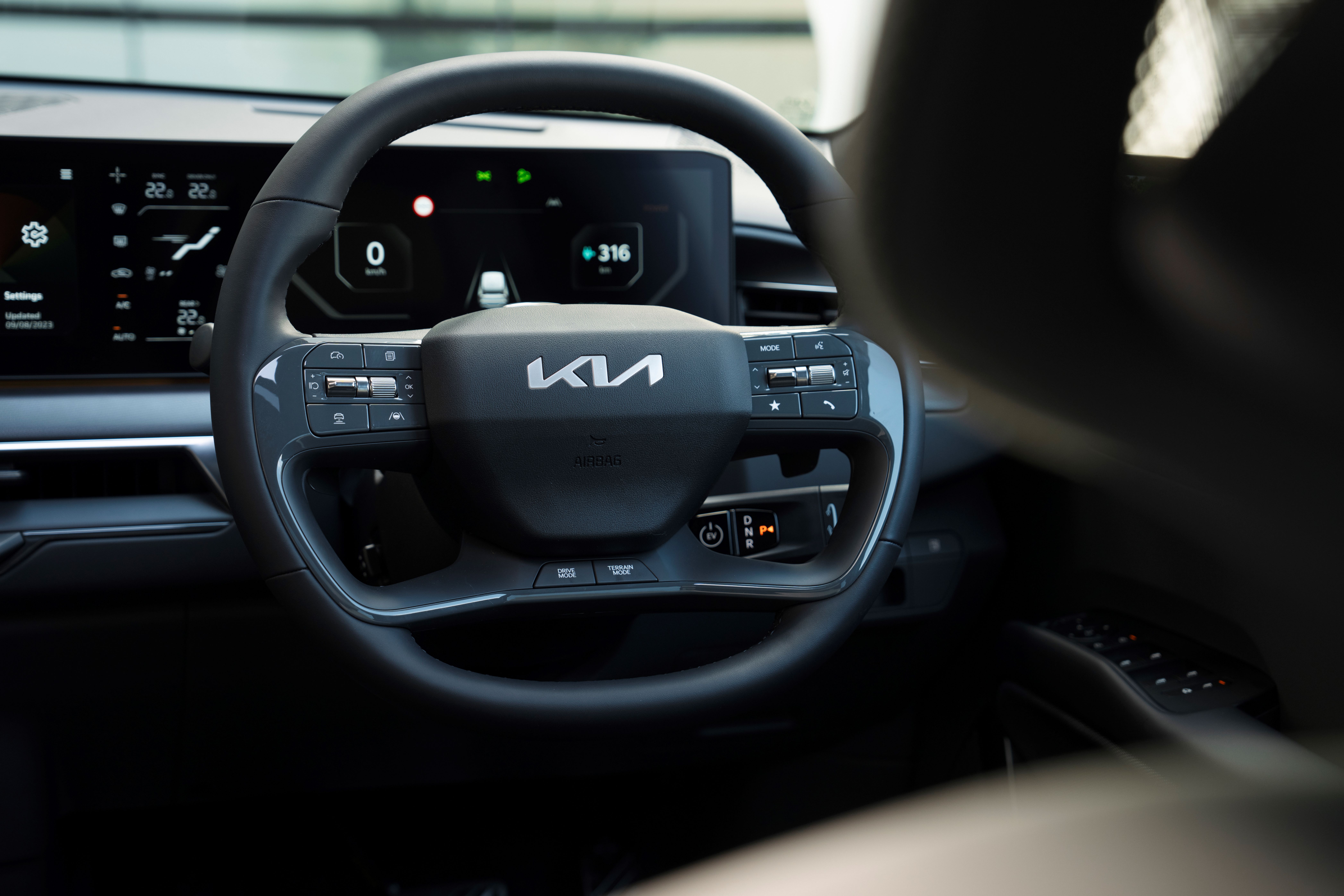Chris Riley tests the 2024 Kia EV9 GT-Line electric seven-seat large SUV with pricing, specs, ride and handling, safety, verdict and everything the over-50 driver needs to know.
Summary: Kia’s very large and very heavy SUV EV is also very expensive. Buyers will be attracted by the useful range, but despite its pretensions to being an off-road vehicle, we doubt many will leave the bitumen.
2024 Kia EV9 seven-seat electric large SUV
Pricing: $121,000 (plus on road costs, excluding any subsidies
Options: premium paint (all but Flare Red) $990, Ocean Blue matte (exclusive to GT-Line, includes ceramic paint protection) $3495
Warranty: Seven-years, unlimited km, electric motor and battery seven-years/150,000km
Safety: not tested
Build location: South Korea
Engine: Dual electric motors But no public charger subscription
Power: 283kW
Torque: 700Nm
Transmission: single speed reduction gear automatic, all-wheel drive
Body: 5015mm (long); 1980mm (wide); 1780mm (high)
Kerb weight: 2636kg The heaviest-ever Kia passenger vehicle
Ground clearance: 177mm
Braked towing capacity: 2500 kg But towing will not do the range any favours
Boot capacity: 333 litres (all rows upright), 828 litres (third row folded), 2318 litres (second and third rows folded), plus 52 litres (front luggage compartment)
Wheels: 21-inch alloy
Tyres: 285/45 R21 Michelin Pilot Tour Wouldn’t be our first choice for off-roading…
Spare wheel: tyre mobility kit … and neither would this
Turning circle: 12.4m
Battery capacity: 99.8kWh
Charge time: 10-100 percent (11kW AC charger) 9 hours, 50kW DC charger 83 minutes
Claimed range: 505km
Official consumption: 22.8kWh/100km
Consumption on test: 20.0kWh/100km (500km)
seniordriver consumption on test: not tested
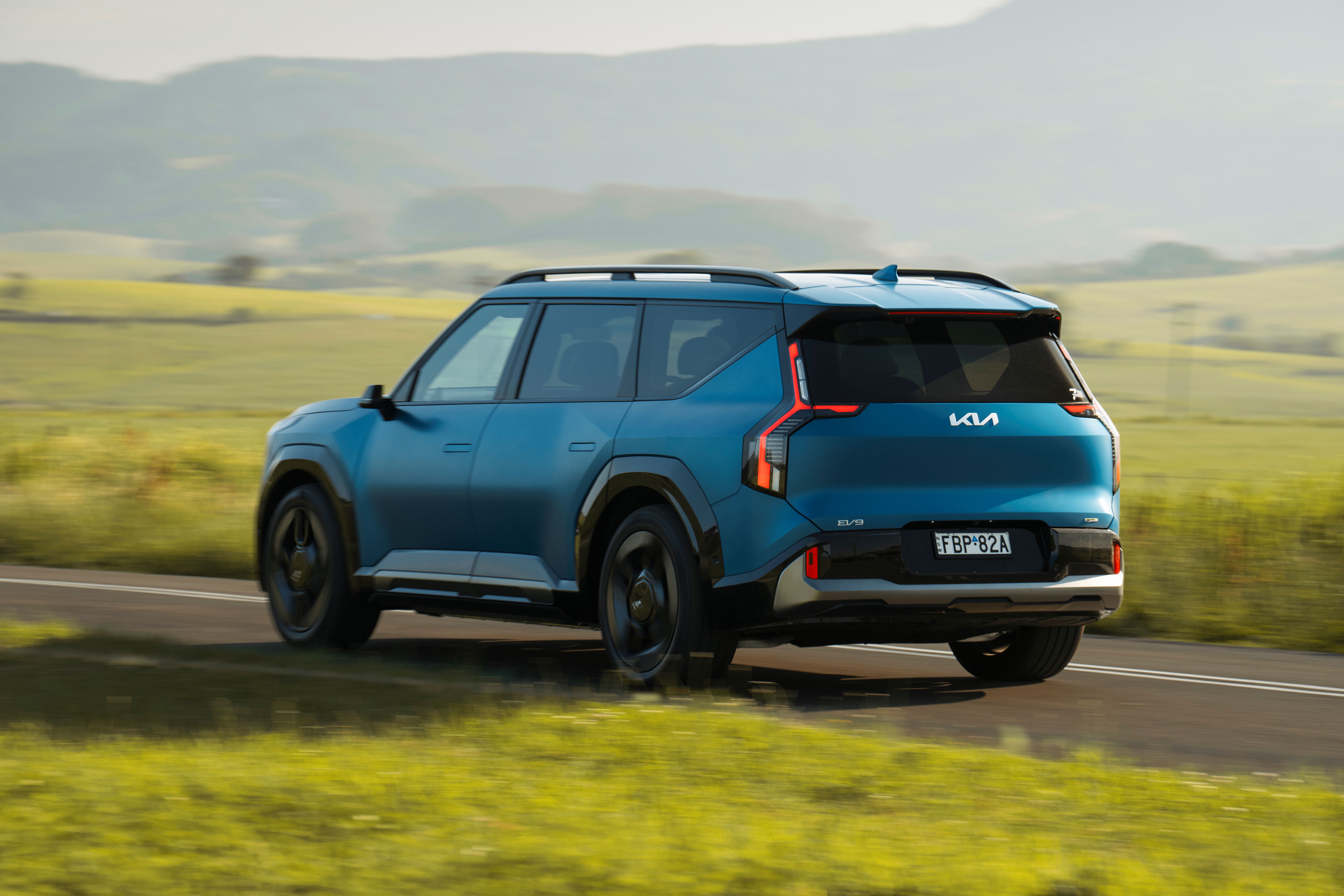
[review]
Sounds too good to be true, but it is true.
EV9 is Kia’s latest and greatest wunderkind, an EV that seats seven and can travel more than 500km on a single charge.
In the early days of the modern electric era, it was suggested that families would have two cars: a compact battery-electric vehicle for city use and larger, hybrid SUV for inter-urban travel.
A decade later they’ve had a rethink and EVs of different shapes and sizes are becoming an increasingly common sight on our motorways, but we’ve still got a way to go.
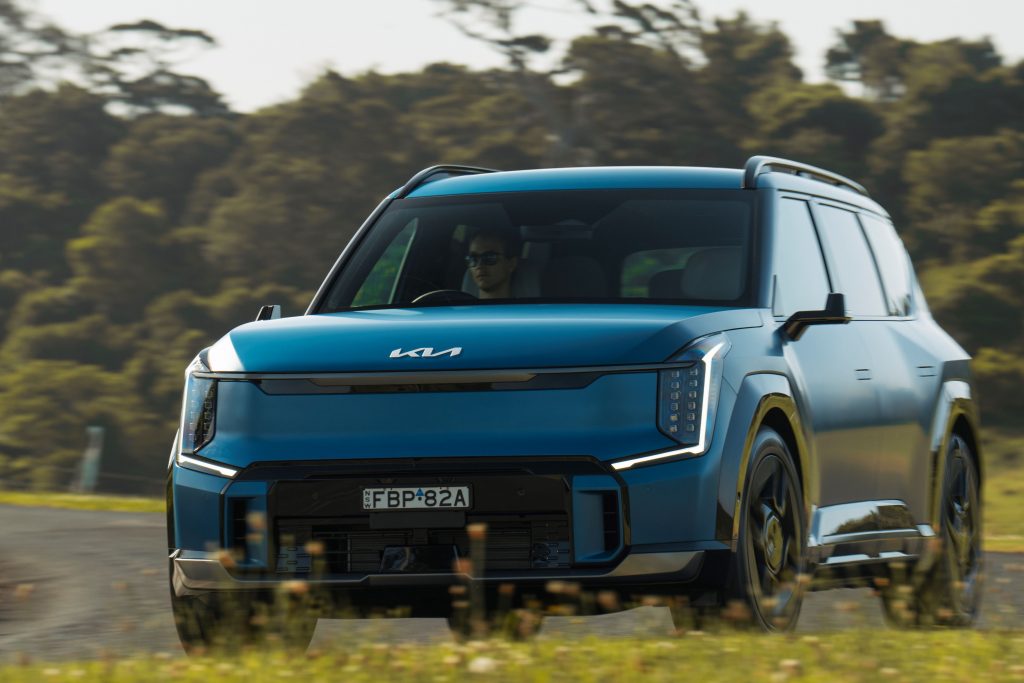
What’s it cost?
It’s big, blunt and unapologetic.
EV9 shares a platform with the EV5 and 6, as well as Hyundai’s Ioniq 5, 6 and 7 and the Genesis GV70.
It comes in three grades: Air, Earth and GT-Line (Earth, Wind and Fire might have been more appropriate), priced from $97,000.
Air has a single electric motor and is rear-wheel drive, Earth and GT-Line have two motors and are all-wheel drive – the latter two priced from $106,500 and $121,000 respectively.
There a choice of seven colours, with premium shades adding $990 to the price and the ultra-premium matter Ocean Blue (with ceramic paint protection) a hefty $3495 .
Air and Earth ride on 19-inch wheels, GT-Line steps up to 21-inch wheels – they’re alloys but fitted with plastic aerodynamic hubcaps.
All three grades are well equipped.
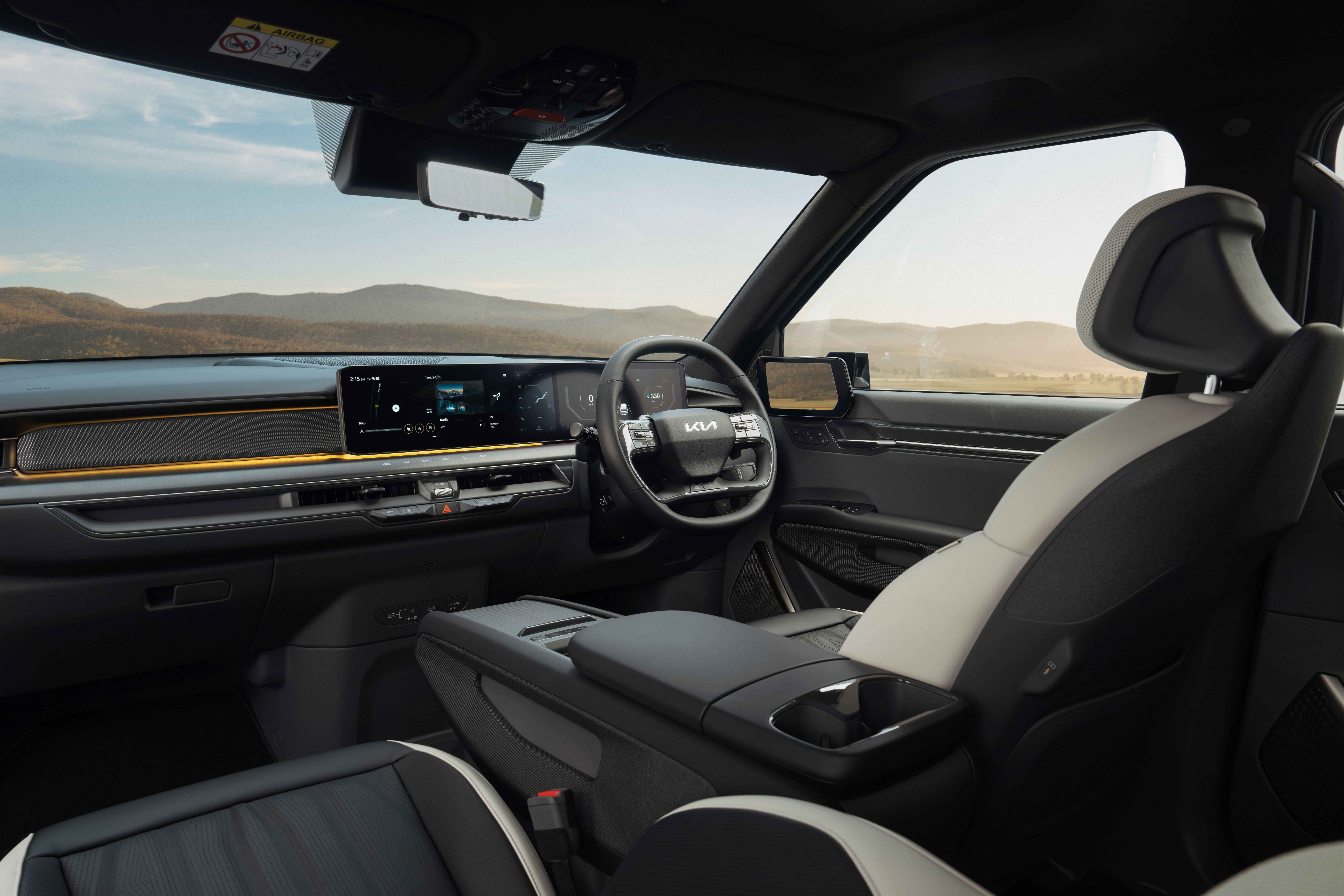
By the time you get to GT-Line there’s leather and three-zone climate air, power-adjust seats with heating and cooling for first and second row, a heated power-adjust steering wheel, ambient interior lighting, dual sunroofs and a power-operated tailgate.
There’s also pop-out door handles, exterior lights are all LED with auto high beam, augmented reality head-up display, intelligent speed limit assist, a 360-degree camera system, remote smart parking and the GT-Line features digital side mirrors which we’ll get to shortly.
A panoramic dashboard combines a 12.3-inch touchscreen and 12.3-inch instrument cluster, separated by a 5.0-inch climate control centre.
Infotainment consists of Bluetooth with multi-connect, AM/FM and digital radio, satellite navigation with 10 years of updates, wired Apple CarPlay and Android Auto, plus Kia’s Sounds of Nature elevator music.
Once set up, fingerprint authentication stores preferences and means the car cannot be stolen, even with the key.
At the same time there’s wireless phone charging, six USB-C ports and two 12-volt outlets and a V2L adaptor which allows external 240-volt devices to be powered.
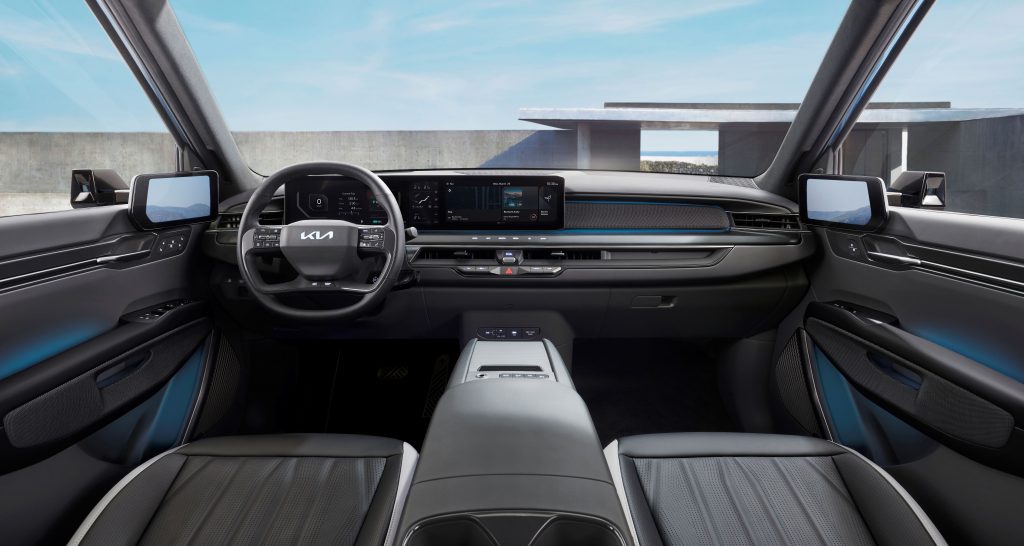
Audio comes from a 14-speaker Meridian sound system, with five speakers, four tweeters, four woofers and a subwoofer.
Kia Connect supports eCall, remote control, vehicle status monitoring and over-the-air updates, and is complimentary for seven years.
Five-star safety includes multiple airbags, autonomous emergency braking (Car-to-Car, Vulnerable Road User, Junction & Crossing and Head-On) as well as a lane support system with lane keep assist (LKA), lane departure warning (LDW) and emergency lane keeping (ELK), and an advanced speed assistance system (SAS).
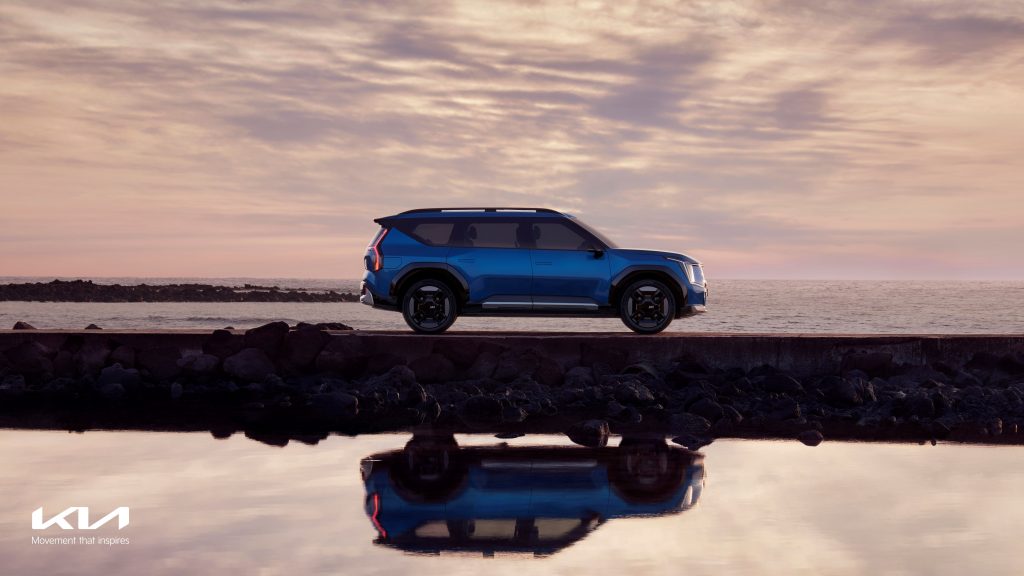
What’s it go like?
For such a big vehicle, the EV9 is surprisingly athletic.
With two motors and 700Nm of instantaneous torque the GT-Line hammers, especially in Sport mode.
But a word of warning: because driving the big feller in this way is guaranteed to eat through your battery and that precious charge takes longer to get back than it does to burn.
Only two other three-row EVs are currently offered in Australia, both of them by Mercedes – the EQB and larger, more expensive EQS SUVs.
The rear-drive Air is equipped with a single electric motor that produces 160kW of power and 350Nm of torque.
It accelerates from rest to 100km/h in 8.2 second and has a WLTP range of 443km.
With two electric motors, one for each axle, all-wheel drive Earth and GT-Line deliver a combined 283kW and 700Nm.
Earth dispatches the dash in 6.0 seconds and has a range of 512km, while the top of the range GT-Line with larger 21-inch wheels and tyres can sprint to 100km/h in just 5.3 seconds, and has a range of 505km.
Most of the time, however, drive in all-wheel drive models is confined to the rear wheels.
WLTP (or the Worldwide Harmonised Light Vehicles Test Procedure) is the latest, more stringent standard and the figure you should look for.
Multi-charging 800V architecture gives the EV9 ultra-fast-charge capability, making it possible to add 232km of range in just 15 minutes.
A full charge from 10 to 80 percent can be completed in as little as 24 minutes in the case of GT-Line. (The GT-Line can be “fully” charged from 10 to 80 percent in as little as 24 minutes using a 350kW fast charger.)
Not quite sure when 80 percent became a ‘full’ charge, but it certainly explains why times keep falling. (It varies from company to company, but the general consensus is that batteries shouldn’t be charged over 80 percent, unless you’re planning a long journey, for example, and want absolute maximum range. Charging beyond 80 percent apparently has a detrimental effect on battery life. This is an issue seniordriveraus has commented on before. Whatever the quoted range, you can immediately reduce it by 20 percent because you should only charge the battery to 80 percent. Then you need to factor in your desire to recharge before the level gets so low as to cause anxiety – we’d suggest not wanting to let the charge fall below 10 percent although many owners might start to get nervous at anything below 20 percent capacity. Now, arithmetic isn’t our strong point, but it seems to us that any EV owner can probably expect a real-world range of 60-70 percent of what is claimed We think this should be explained when car companies quote an anticipated range. Ed.)
Bear in mind too, that to preserve battery life, the charge rate slows after 80 percent, and the EV9 is no exception.
At more than 5.0 metres in length and weighing from 2960 to 3240kg depending on model, EV9 is a big unit and needs to be, to deliver its seven-seat capacity and petrol-like range.
You don’t want to be stuck with the ‘fam’ by the side of the road out in the boonies somewhere.
The batteries alone weigh 560kg.
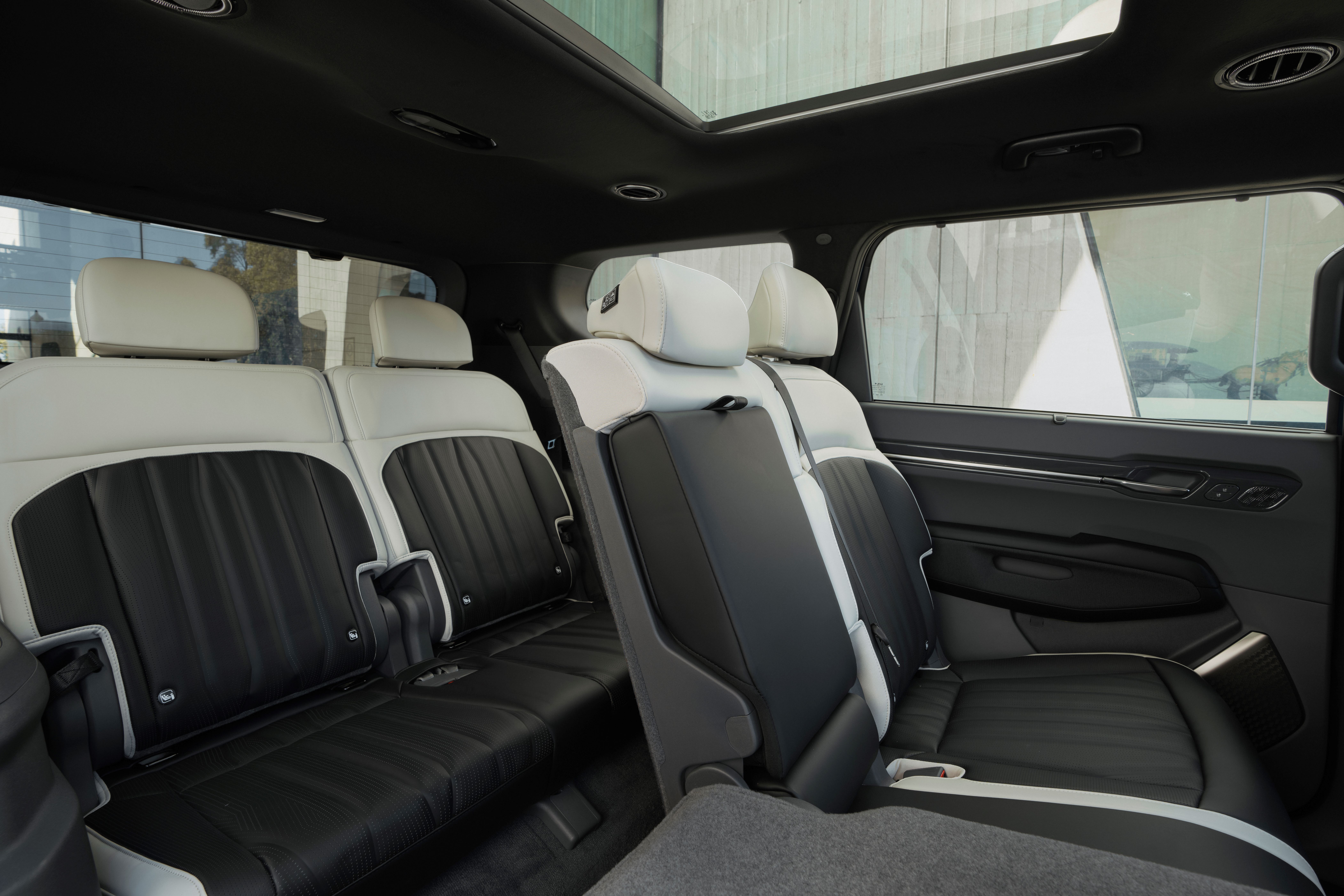
Kia reckons range anxiety is a thing of the past with DC fast charging, reducing the time taken to mere minutes.
But the larger the battery, the longer it takes to recharge and some, like the battery in the EV9, can take a very long time.
The battery in the single motor version is 76.1kW in size, while the unit in the dual motor version is almost 100kW.
With the cable supplied and a standard single phase 10A power point, the 76.1kW battery would take 31.42 hours to fully recharge.
The 99.8kW battery would take 41 hours and 35 minutes. (That’s according to the Green Vehicle Guide.)
In reality, the EV9 is probably the first EV that we’ve tested that cannot practically be recharged at home without a wallbox.
So it becomes a question of whether you have access to a commercial charger, how much it costs per kWh and, most importantly, how long it will take (and what you plan to do while twiddling your thumbs).
We note the tendency of some reviewers to gloss over this aspect of EV ownership.
Before rushing out to buy the latest and greatest EV, spend some time considering how you’re going to recharge your new car.
We know of one couple who actually traded back their EV after a couple of months because the whole charging regime became too much for them.
At the end of the day, you’re not just buying a car, you’re buying into a lifestyle.
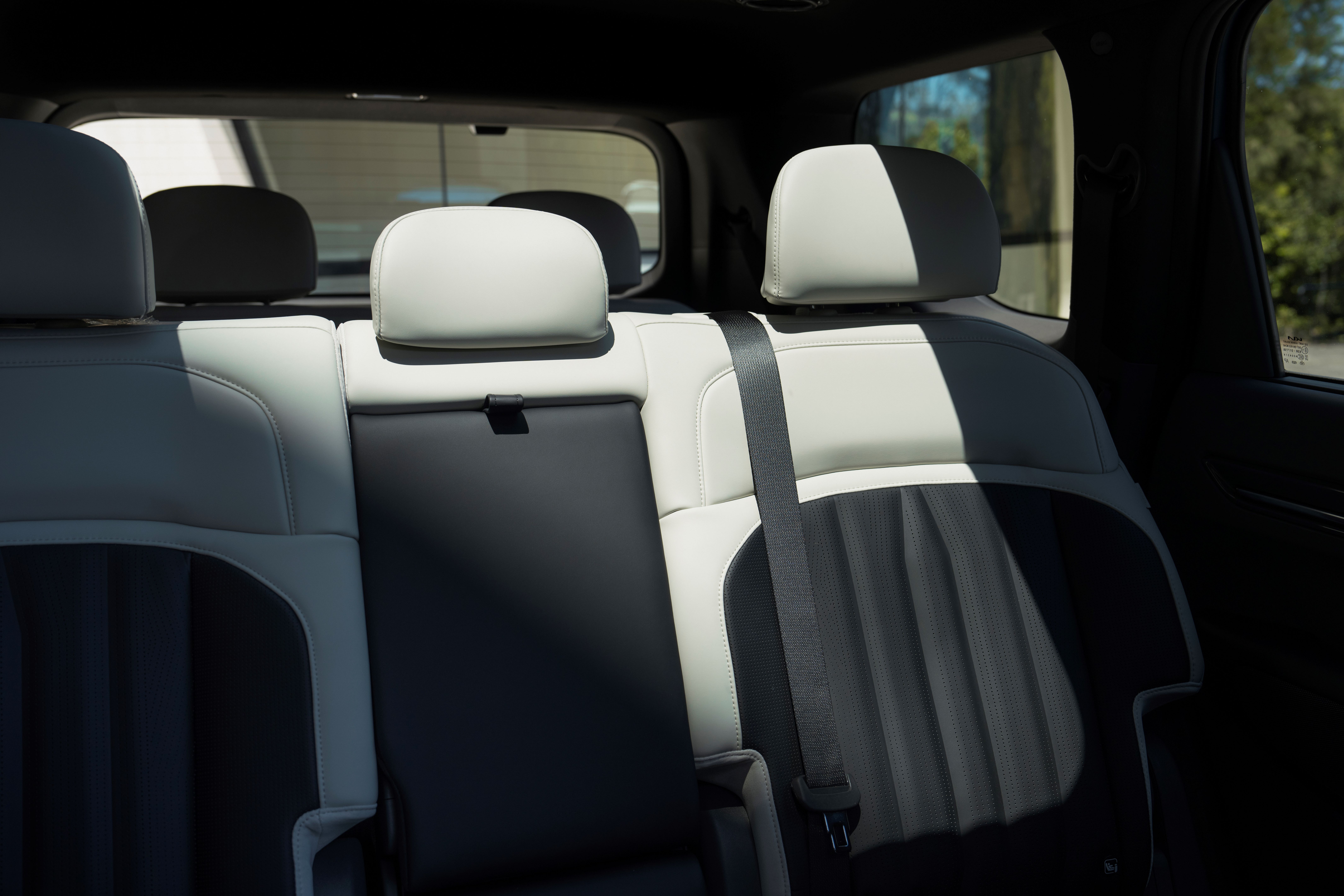
With all three rows in use EV9 provides 333 litres of cargo space or 828 litres with the third row folded. With both rows folded, it’s 2318 litres.
The rear-drive Air has a braked towing capacity of 900kg while AWD models can tow up to 2500kg.
As well as Sport and Eco drive modes, Snow, Mud and Sand terrain modes are offered.
But with just 177mm of ground clearance, we wouldn’t be taking the EV9 off road anytime soon.
In terms of power consumption, GT-Line is rated at 22.8 kWh/100km.
Our test vehicle was getting 20.0 kWh after close to 500km of city, suburban and country driving.
In comparison a Tesla Model 3 uses 13.7 kWh; the MG ZS EV 18.5 kWh per 100km.
Of the three grades available, Earth is probably the smart choice, with plenty of power and the greatest driving range.
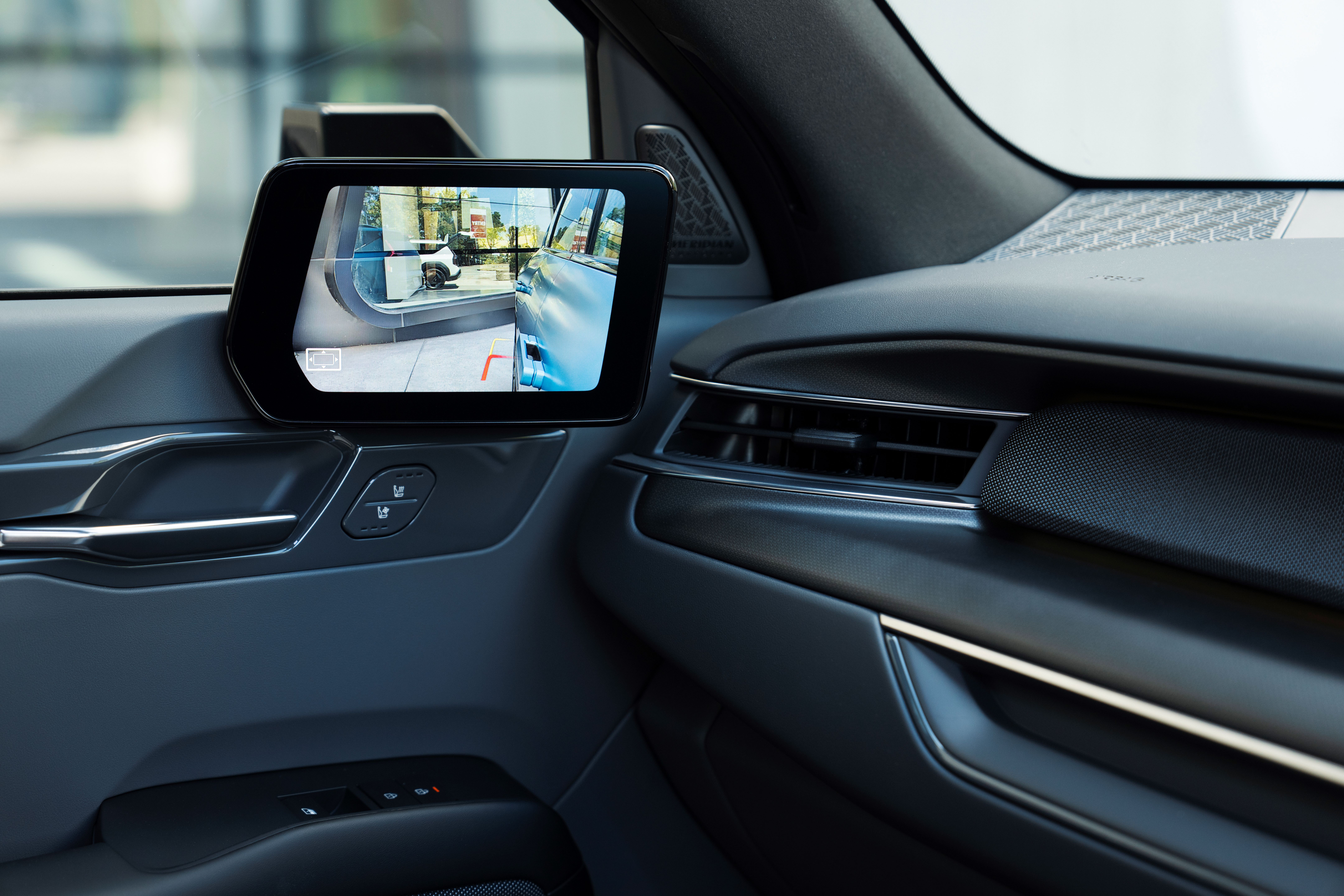
We wouldn’t consider the GT-Line based purely on the silly digital mirrors. Who the hell signed off on them? Two cameras replace the exterior mirrors, with small video screens located inside each of the doors. Obviously they take a bit of getting used to, but apart from being new and cool, what practical purpose do they serve?
Experience has shown that reversing cameras become dirty and fail to transmit a clear view of the surroundings. What’s to say the lenses of these cameras won’t become dirty too? In fact, the mirrors of our test vehicle became clouded for several minutes one morning because of condensation. At the very least it poses safety questions.
The mirrors can also cause motion sickness, as my wife discovered.
Sorry, but tech for tech’s sake is a bad idea.
Ditto the electronic interior mirror.
It’s difficult to bring into focus with multifocal glasses, but at least it can be switched off.
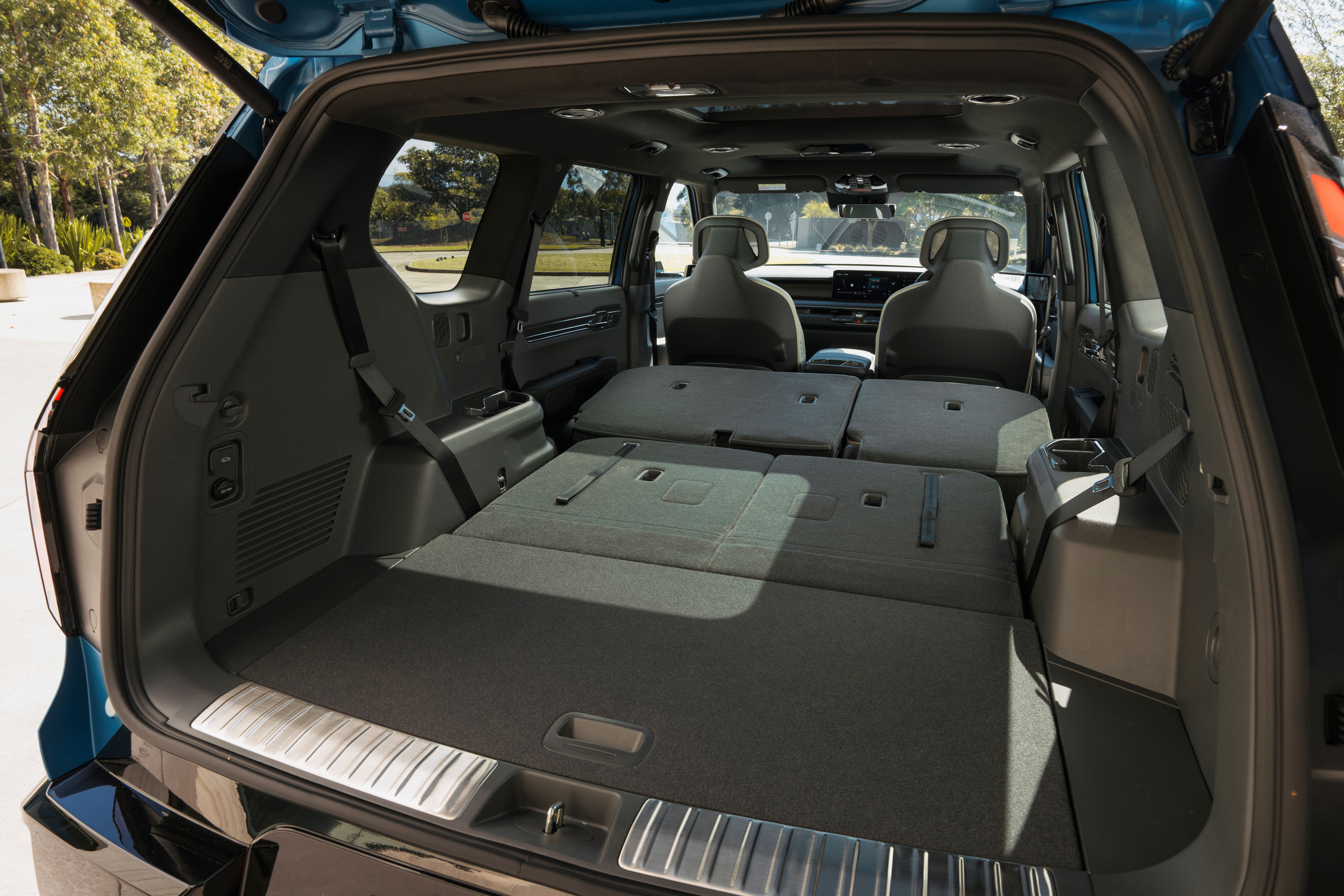
The ride quality is amazingly good for such a large heavy vehicle.
Like other Kias, the EV9 benefits from local tuning, with strut front suspension with frequency selective dampers and multi-link rear suspension featuring self-levelling dampers, and rack-mounted motor-driven power steering.
Active noise cancellation keeps background noise to a minimum.
Distracting, however, is the constant beeping from the intelligent speed assist system (when you exceed the speed limit).
It can be switched off, but you have to do so every time you re-start the vehicle.
Checking out the touchscreen we were surprised to find that Apple CarPlay and Android Auto are offered in wired form only.
Seriously? This thing is supposed to be cutting edge (an over-the-air update is expected to rectify this).
Below the touchscreen is a row of touch-sensitive buttons for quick access to different features such as audio and navigation.
They can be difficult to operate on the move with no support to steady fingers and the white labels are almost invisible in strong sunlight.
The 14-speaker Meridian audio system is a keeper however.
What we like
- Looks
- Long range
- Strong performance
- Room for the family
What we don’t like
- Digital mirrors
- Electronic interior mirror
- Cruise control difficult to use
- Volume control difficult to use
- Can’t see head-up display with polarised sunglasses
What over-50 drivers need to know
The Kia EV9 is an impressive piece of engineering, that’s for sure.
Who would have thought it was even possible to power a stonking great seven-seater with an electric motor – make that two electric motors.
It goes like stink and it’s got some decent range, so you don’t need to worry about running out of juice – it’s even fun to drive.
But at the end of the day we’re left wondering who’s going to buy one? For that matter, who really needs such a vehicle?
seniordriver comments
It certainly wasn’t so long ago that the idea of a $100,000+ Kia would have been laughable, but the EV9 is setting a new benchmark for the brand, and buyer interest, even at this rarefied level, is keen.
While to V2L adaptor is a “gee whizz” feature, we wonder just how much use it will get in the real world, although we can see people in campsites finding it useful. Tradies too, but we can’t see too many of them buying EV9s.
Weighing in at an almost unbelievable three tonnes (and more in some instances), you’ll need to take care in car parks and perhaps even on your own driveway and garage. There may also be some issues with ferries, if you have occasion to use them. And three tonnes won’t make genuine off-roading much fun, either. Especially with just 177mm of ground clearance.
We’re with Chris when it comes to those silly digital mirrors. It’s another case of being different for the sake of being different, and offers no practical benefit. It’s the same with the electronic internal mirror. In our experience, it can be quite a challenge to adjust your focus from short to long distance, as you need to do with this mirror.
We’ll be watching with interest to see the progress of sales of Kia’s most expensive model yet.
